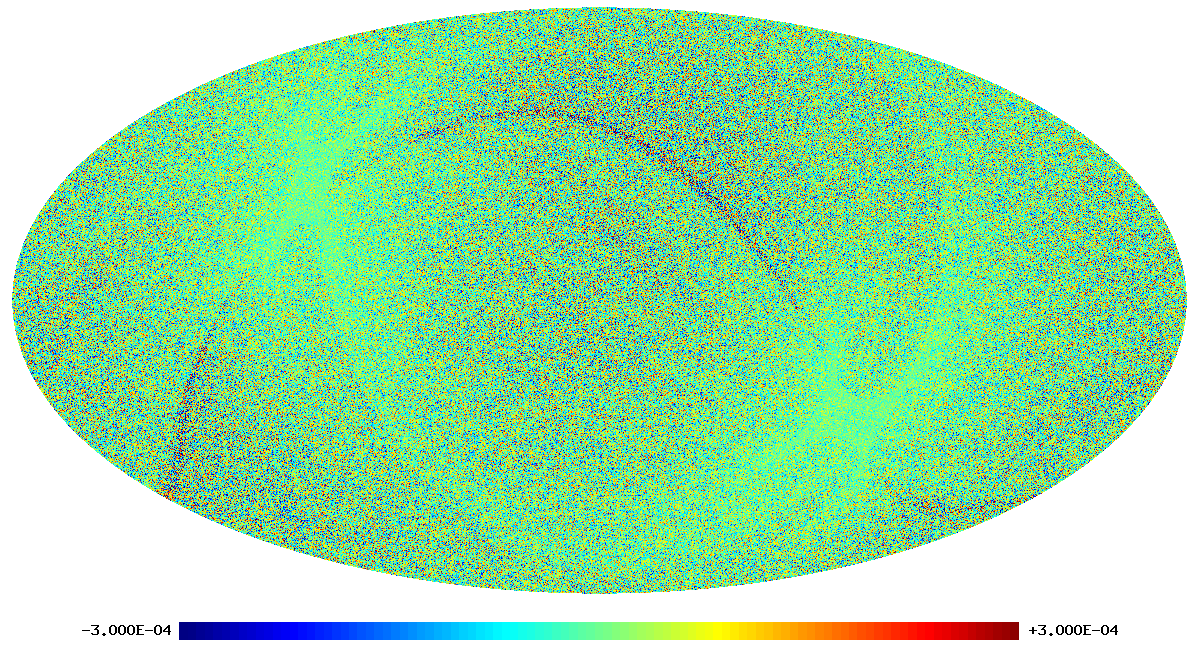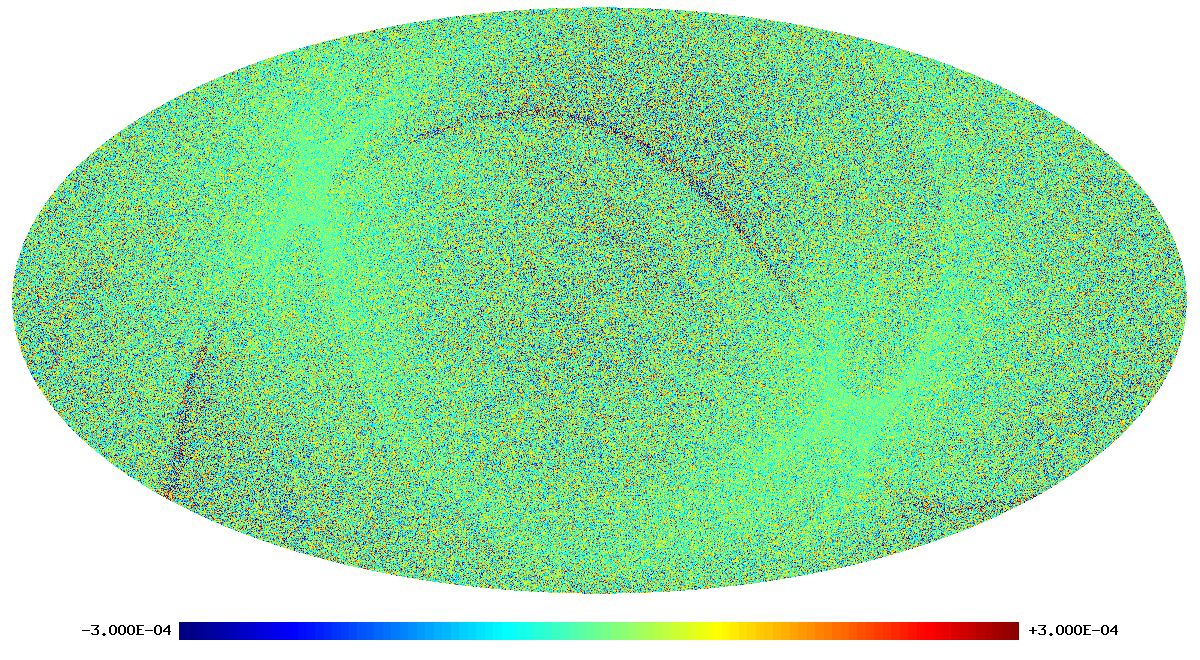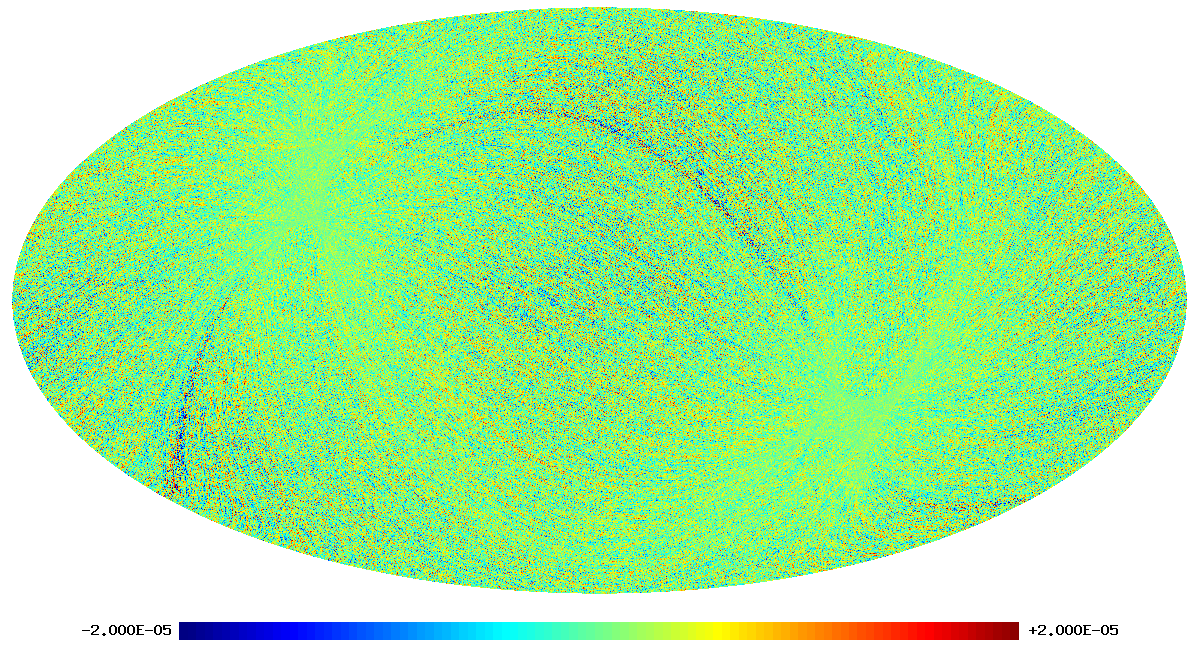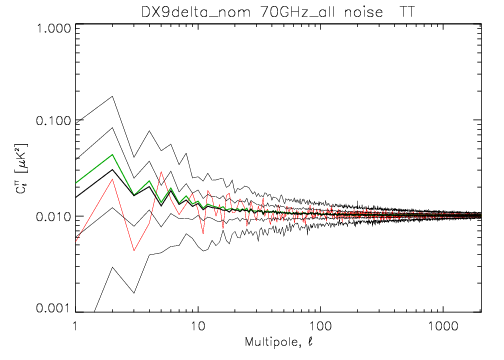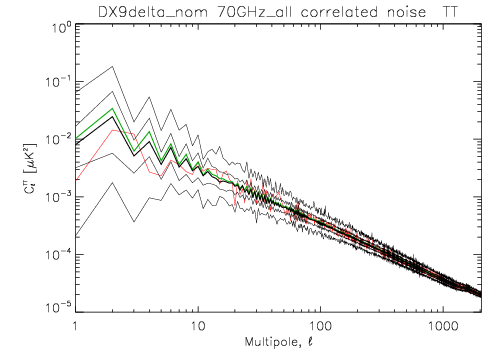Difference between revisions of "Map-making LFI"
| Line 32: | Line 32: | ||
Basically, necessary information for someone to reconstruct the maps from the same inputs | Basically, necessary information for someone to reconstruct the maps from the same inputs | ||
| + | |||
| + | |||
| + | Many of the information listed above can be filled only after we know exatcly which data products are released and in which file format. | ||
| + | |||
| + | |||
| + | Insert a table of maps delivered: | ||
| + | -file name | ||
| + | -radiometers included | ||
| + | -PID/OD range | ||
| + | -resolution | ||
| + | -polarization included or not | ||
| + | -sky coverage | ||
| + | -baseline length | ||
| + | |||
| + | |||
| + | Explain the format of the files, what is in what column, in what units. | ||
| + | |||
| + | Information common for all maps: | ||
| + | LFI maps were constructed with the Madam map-making code (version 3.7.4). | ||
| + | Maps are in Healpix format, in nested pixeling scheme. Each of the LFI maps has three columns, which represent the three Stokes parameters I,Q,U. | ||
| + | The maps are in K_cmb units and galactic coordinate system. | ||
| + | |||
| + | Maps are constructed in galactic coordinates, i.e. we rotate the detector pointings from ecliptic to galactic coordinate system befire running the map-making pipeline. | ||
| + | The conversion from ecliptic to galactic coordinate system is described by rotation matrix | ||
| + | ( -0.054882486, 0.494116468, -0.867661702, | ||
| + | -0.993821033, -0.110993846, -0.000346354, | ||
| + | -0.096476249, 0.86228144, 0.497154957 ) | ||
| + | |||
| + | Insert a table of horn weights. | ||
| + | |||
| + | Noise prior is constructed based on a four-parameter noise model (sigma, knee frequency, slope, and minimum frequency).. | ||
| + | Liste the noise parameters here of refer elsewhere. | ||
| + | |||
| + | Handling of bad pixels: | ||
| + | To solve the three Stokes maps I,Q,U in a given pixel, we need sufficient coverage in the psi angle, which defines the direction of polarization sensitivity of a sample. In general, two horns, each having two radiometers with orthogonal polarization angles provide sufficient sensitivity. | ||
| + | As the criterion for sufficient sensitivity we have used the rcond (reverse conditioning number) value of the 3x3 pixel matrix. | ||
| + | Pixels with rcond below 0.01, or with no detections at all, were rejected from the maps. Rejected pixels are marked by the special value Healpix_undef=-1.6375e30, | ||
| + | |||
==Noise Covariance Matrix== | ==Noise Covariance Matrix== | ||
Revision as of 12:26, 22 November 2012
Contents
Map-making[edit]
EK: This section is supposed to be a practical manual to the data products the way in which we crestes the maps. This section should thus include:
Description of the map products:
-what data range does each map cover
-what combination of radiometers
-baseline length
-flags applied
-mask applied
-radiometer weights used
-resolution
-exact recipe for construction of the noise prior
-handling of bad pixels
-how are uncovered pixels marked
-relation to toi and pointing objects
-auxiliary data: white noise covariance
Basically, necessary information for someone to reconstruct the maps from the same inputs
Many of the information listed above can be filled only after we know exatcly which data products are released and in which file format.
Insert a table of maps delivered:
-file name
-radiometers included
-PID/OD range
-resolution
-polarization included or not
-sky coverage
-baseline length
Explain the format of the files, what is in what column, in what units.
Information common for all maps: LFI maps were constructed with the Madam map-making code (version 3.7.4). Maps are in Healpix format, in nested pixeling scheme. Each of the LFI maps has three columns, which represent the three Stokes parameters I,Q,U. The maps are in K_cmb units and galactic coordinate system.
Maps are constructed in galactic coordinates, i.e. we rotate the detector pointings from ecliptic to galactic coordinate system befire running the map-making pipeline. The conversion from ecliptic to galactic coordinate system is described by rotation matrix
( -0.054882486, 0.494116468, -0.867661702,
-0.993821033, -0.110993846, -0.000346354,
-0.096476249, 0.86228144, 0.497154957 )
Insert a table of horn weights.
Noise prior is constructed based on a four-parameter noise model (sigma, knee frequency, slope, and minimum frequency).. Liste the noise parameters here of refer elsewhere.
Handling of bad pixels: To solve the three Stokes maps I,Q,U in a given pixel, we need sufficient coverage in the psi angle, which defines the direction of polarization sensitivity of a sample. In general, two horns, each having two radiometers with orthogonal polarization angles provide sufficient sensitivity. As the criterion for sufficient sensitivity we have used the rcond (reverse conditioning number) value of the 3x3 pixel matrix. Pixels with rcond below 0.01, or with no detections at all, were rejected from the maps. Rejected pixels are marked by the special value Healpix_undef=-1.6375e30,
Noise Covariance Matrix[edit]
Half-ring jackknife Noise Maps[edit]
Overview[edit]
In order to estimate the noise directly at the map level and in the angular power spectra, we divided the time-ordered data into two halves and produced half-ring jackknife maps as described in Planck First Results: II. The Low Frequency Instrument performance and data processing.
Briefly: Instead of using the full time ordered data as described above, we produced two sets of maps using either only the first half of each pointing period (map named $\mathbf{j_1}$ below) or only the second half of each pointing period (map named $\mathbf{j_2}$). At each pixel $p$, these half-ring jackknife maps $\mathbf{j_1}$ and $\mathbf{j_2}$ contain the same sky signal, since they result from the same scanning pattern on the sky. However, because of instrumental noise, the maps $\mathbf{j_1}$ and $\mathbf{j_2}$ are not identical.
We estimated the noise level in each map $\mathbf{m}$ made using the full(ring) data, by constructing a half-ring difference map
$\mathbf{n_{m}}(p) = [ \mathbf{j_1}(p) - \mathbf{j_2}(p)] \ / \ \mathbf{w_{\rm hit}}(p)\,,$
with weights
$\mathbf{w_{hit}}(p) = \sqrt{ \mathbf{hit_{full}}(p) \left[ \frac{1}{\mathbf{hit_1}(p)} +
\frac{1}{\mathbf{hit_2}(p)} \right]}\,$.
Here $\mathbf{hit_{full}}(p) = \mathbf{hit_1}(p) + \mathbf{hit_2}(p)$ is the hit count at pixel $p$ in the full map $\mathbf{m}$, while $\mathbf{hit_1}$ and $\mathbf{hit_2}$ are the hit counts of $\mathbf{j_1}$ and $\mathbf{j_2}$, respectively. The weight factor $\mathbf{w_{hit}}(p)$ is equal to $2$ only in those pixels where $\mathbf{hit_1}(p) = \mathbf{hit_2}(p)$. In a typical pixel, $\mathbf{hit_1}(p)$ will differ slightly from $\mathbf{hit_2}(p)$ and hence the weight factor is $\mathbf{w_{hit}}(p) > 2$.
The half-ring difference maps $\mathbf{n_{m}}$ are the most direct measure of the noise in the actual maps. The other noise estimates (NCVM and noise Monte Carlo) rely on specific modelling of the noise and this modelling can be validated by comparing to the half-ring difference maps. However, the half-ring difference maps can only capture the noise that varies faster than half of the duration of the pointing period, i.e., the noise whose frequency is $f \gtrsim 2/20\,\mbox{min} = 1.7\,$mHz.
We calculated the noise maps $\mathbf{n_{m}}$, from half-ring jackknife maps for temperature (I) and polarization (Q and U) and as a first quality check of the maps (and as one of the tests of the whole data processing pipeline up to the maps) tested both numerically and visually that these noise maps divided pixel-by-pixel by square root of the white noise covariance maps were approximately Gaussian with variance near to unity. Temperature noise maps for the nominal survey and for the first and second sky surveys are shown in the next subsection. Further we calculated from the noise maps the temperature and polarization (E and B mode) auto-correlation and cross-correlation noise angular power spectra by anafast and compared to these the results from the white noise covariance matrices and from the noise Monte Carlo simulations. A similar comparison was made between downgraded half-ring noise maps, downgraded noise Monte Carlo maps and the low resolution noise covariance maps. Detailed results are presented in the Systematic Effects paper.
Examples of Half-ring Difference Maps and Noise Angular Power Spectra[edit]
Hit Count Weighted Half-ring Difference Maps[edit]
Here we show some hitcount weighted half-ring difference maps, i.e., noise maps for temperature. The columns are for different LFI frequencies: 30, 44, and 70 GHz. The rows are the nominal survey (a bit more than 1 year of observations), survey 1 (the first sky survey, approx first half a year of observations) and survey 2 (the second sky survey, approx the second half a year of observations). Some features are visible in particular in the galactic plane. These are due to "gradient leakage". (In regions where the gradient in the sky signal is very large even a tiny difference in the pointing of the first and second half of each pointing period causes the signal to "leak" to the half-ring difference map. In practice this is not a problem for noise estimation, since these regions - the galaxy, orion, crab nebula, etc - will be masked in the cosmology analysis.
Half-ring difference maps calculated at the native nside 1024 resolution. Columns: frequency (30, 44, 70 GHz), rows: sky survey (nominal, survey_1, survey_2).
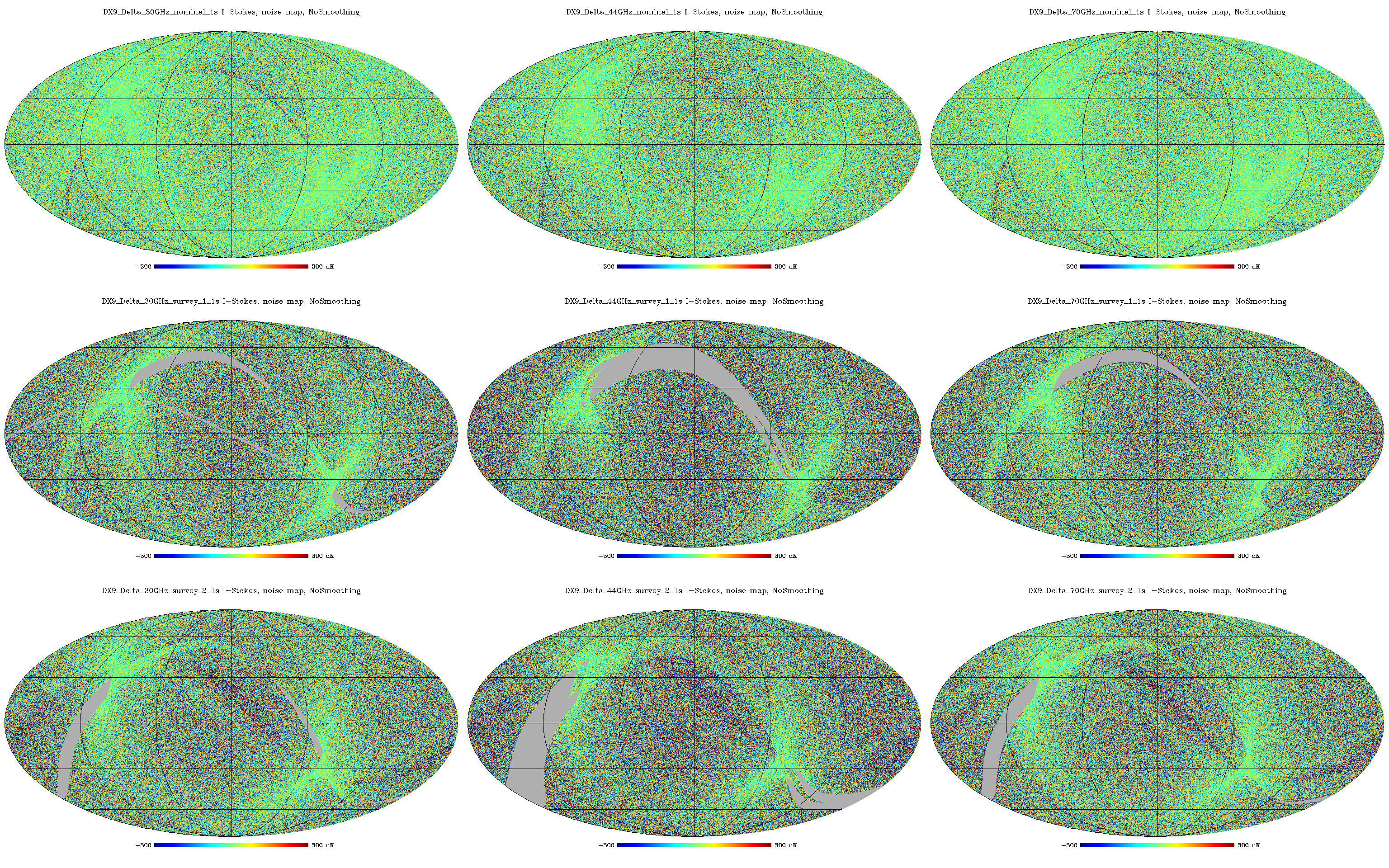
Half-ring difference maps (the same as above, but) smoothed with 60 arcmin fwhm Gaussian. Columns: frequency (30, 44, 70 GHz), rows: sky survey (nominal, survey_1, survey_2).
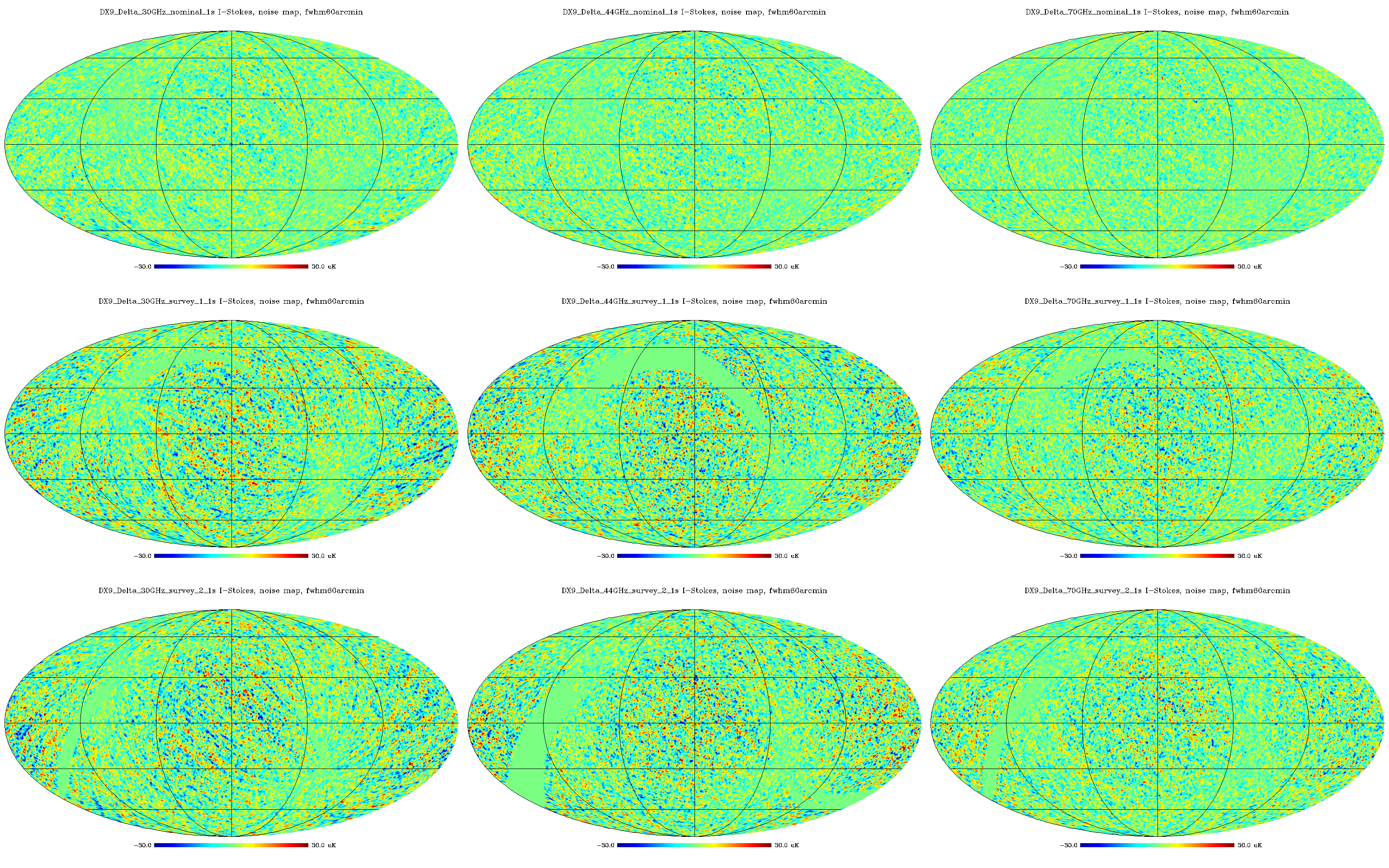
Hit Count Weighted Half-ring Difference Maps Normalized by sqrt of white noise variance at each pixel[edit]
Now we show the same as above, but divided by the square root of the estimate of white noise variance in each pixel. These normalized noise maps should be approximately Gaussian with a unit variance (at the native resolution), apart from some stripes that are due to correlated (non-Gaussian) 1/f noise. The large-scale 1/f noise is more apparent in the smoothed version of the figure that follows after the native resolution version.
Normalized Half-ring difference maps calculated at the native nside 1024 resolution. Columns: frequency (30, 44, 70 GHz), rows: sky survey (nominal, survey_1, survey_2).
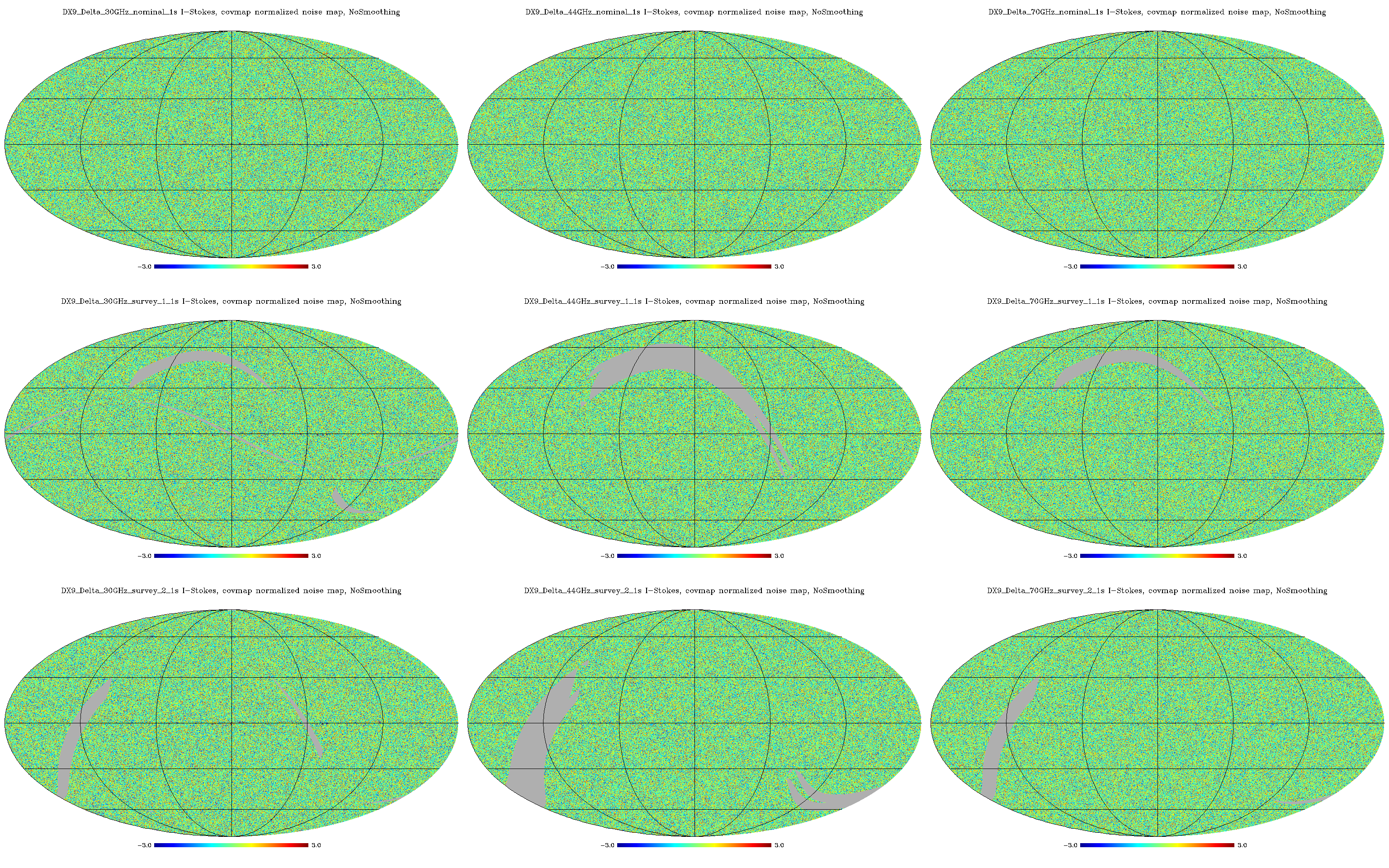
Normalized Half-ring difference maps (the same as above, but) smoothed with 60 arcmin fwhm Gaussian. Columns: frequency (30, 44, 70 GHz), rows: sky survey (nominal, survey_1, survey_2).
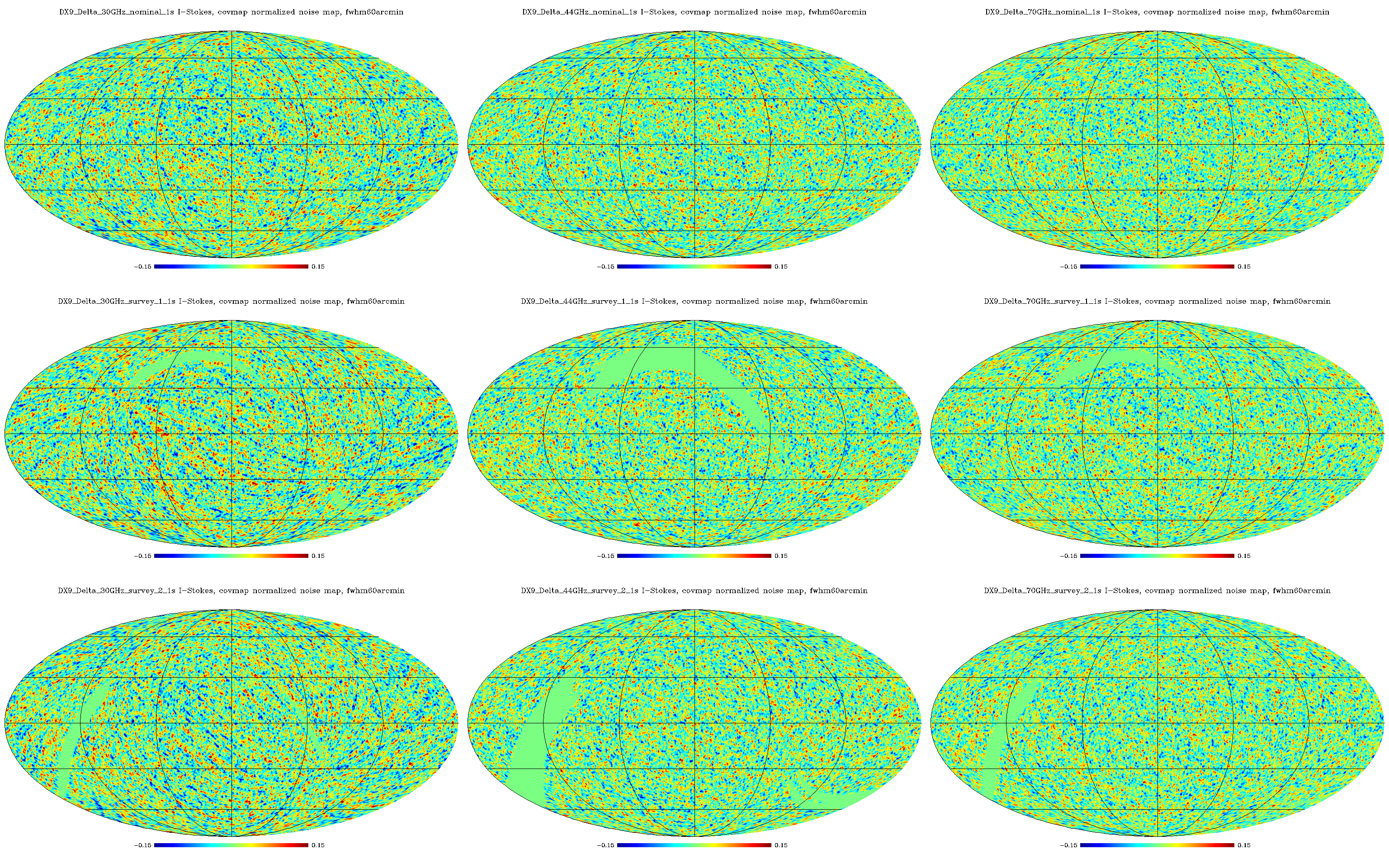
Noise Anglular Power Spectra from Half-ring Difference Maps[edit]
The noise angular power spectra calculated by anafast from half-ring difference temperature maps and normalized by the sky coverage to estimate the noise level if there was a full sky coverage in order to make a comparison of different surveys easier. Columns: frequency (30, 44, 70 GHz). Colors: black = nominal, red = survey_1, blue = survey_2.

Noise Monte Carlo Simulation[edit]
Overview[edit]
Calculating and handling full pixel-to-pixel noise covariance matrices for Planck maps if feasible only at low resolution. To support the analysis of high-resolution maps, a Monte Carlo set of noise maps were produced. These maps were produced from noise timelines using the same map-making procedure as for the flight data. In the noise Monte Carlo it was possible to follow exactly the map-making procedure used for the flight maps, whereas for the calculation of noise covariance matrices some approximations had to be made. Such noise Monte Carlos were produced at two levels of the analysis: 1) LFI Monte Carlo (MC) as part of the LFI data processing, and 2) Full Focal Plane (FFP) Monte Carlo as part of the joint HFI/LFI data processing. This page describes the LFI noise MC. For the FFP MC, see HL-sims.
Inputs[edit]
The noise MC uses a three-parameter (white noise level ($\sigma$), slope, and knee frequency ($f_\mathrm{knee}$)) noise model, where the noise consists of white noise and correlated ($1/f$) noise and the latter has a power spectrum
- $ P(f) = \frac{2\sigma^2}{f_\mathrm{sample}}\left(\frac{f}{f_\mathrm{knee}}\right)^\mathrm{slope} $.
Here $f_\mathrm{sample}$ is the sampling frequency of the instrument. The noise parameters were determined separately for each radiometer as described in TOI-Noise LFI, assuming they stayed constant over the mission.
The detector pointing was reconstructed from satellite pointing, focal-plane geometry, pointing correction (tilt angle), and sample timing, using Level-S simulation software. The same pointing solution (two focal planes) was used as for the LFI flight maps. Due to numerical accuracy, the detector pointing in the noise MC was not exactly the same as for the flight maps, but some data samples (of the order of one in a thousand) whose pointing was near the pixel boundary ended up assigned to the neighboring pixel. During the map-making from the flight data, a gap file was produced to represent the samples that were omitted from map-making due to various flags. This gap file was used in the noise MC instead of the full set of flags. The flight map-making used a destriping mask to exclude regions of strong signal gradients from contributing to the noise baseline solution. These same destriping masks (one for each frequency channel) were used for the noise MC.
Production[edit]
The noise was generated internally in the Madam map-making code using a Stochastic Differential Equation (SDE) method, to avoid time-consuming writing and reading noise timelines to/from disk. Noise for each pointing period was generated separately, using a double-precision random number seed constructed from the realization number, radiometer number, and the pointing period number; to allow regeneration of the same noise realization when needed. White noise and $1/f$ noise were generated separately.
The same map-making code (Madam) with the same parameter settings was used for the noise MC as for the flight maps. In addition to the destriped maps from the full noise (output maps), also binned maps from just the white noise (binned white noise maps) were produced; they represent the white noise part of the output maps. The difference between these two maps represent the residual correlated noise in the output map. The maps were made at Healpix resolution $N_\mathrm{side} = 1024$. For low-resolution analysis, these maps were downgraded (and the temperature part was smoothed) to $N_\mathrm{side} = 32$ and $N_\mathrm{side} = 16$.
When the noise MC for the first Planck data release was performed, calibrated data for five sky surveys were available. In addition to frequency maps for the nominal survey and the full survey (all five sky surveys), single-survey and 70 GHz horn-pair maps were produced in the noise MC, resulting in 27 different cases of LFI maps, a subset of the map cases produced from the flight data. For each case 102--1026 realizations were produced.
Usage[edit]
These noise Monte Carlo maps were used for a number of things in LFI data analysis. They were compared to the low-resolution noise covariance matrices, generated for the same noise model to see the impact of the approximations in the noise covariance matrix calculation. They were compared to the half-ring noise maps to see how well the noise model matches the noise in the flight maps (noting, however, that the half-ring noise maps misrepresent the lowest noise frequencies in the flight maps, and contain some effects from the sky signal). They were also used in power spectrum estimation and non-Gaussianity estimation.
Examples[edit]
As an example, we show below images of the first realization of the 70 GHz frequency map noise for the nominal survey. The images are in order: destriped full noise, binned white noise, residual correlated noise. Note that it is difficult to see any difference between the first too images, since the residual correlated noise is more than an order of magnitude below the white noise level. The units are CMB K.
The following two images show the statistics of the angular power spectra of 101 realizations of the 70 GHz frequency map noise for the nominal survey. The thick black line shows the median $C_\ell$, and the green line the mean $C_\ell$. Thin black lines show the minimum, 16% quantile, 84% quantile, and the maximum $C_\ell$. The red line is the 102nd realization. The first plot is for the full noise in the output map, the second plot is for the residual correlated noise.
Operation Day definition is geometric visibility driven as it runs from the start of a DTCP (satellite Acquisition Of Signal) to the start of the next DTCP. Given the different ground stations and spacecraft will takes which station for how long, the OD duration varies but it is basically once a day.
(Planck) Low Frequency Instrument
(Planck) High Frequency Instrument
Cosmic Microwave background
